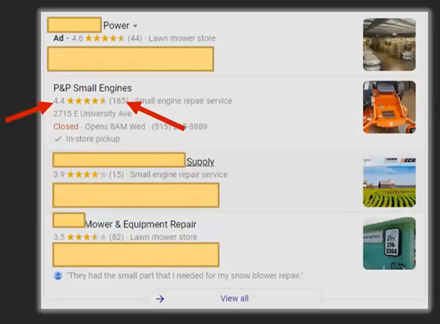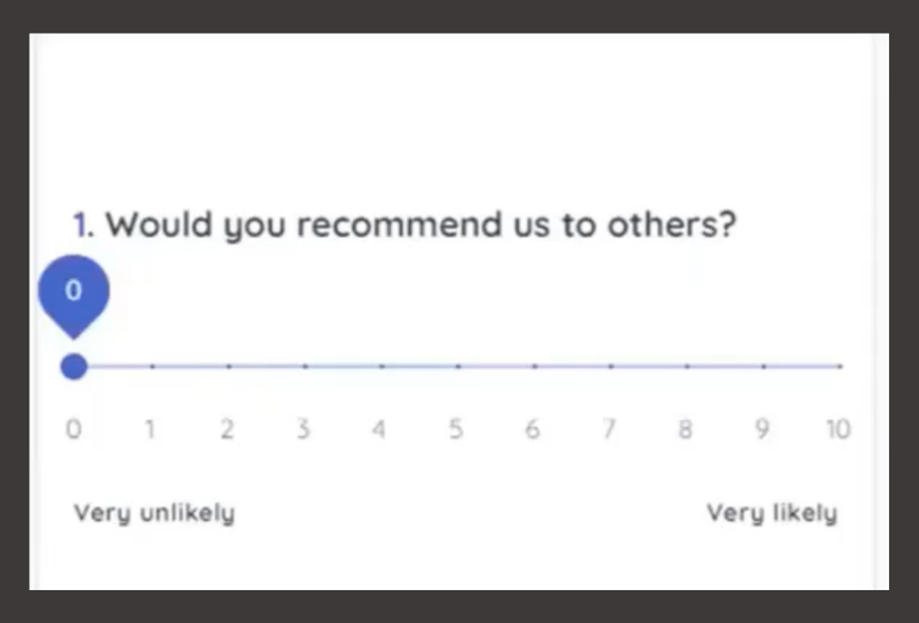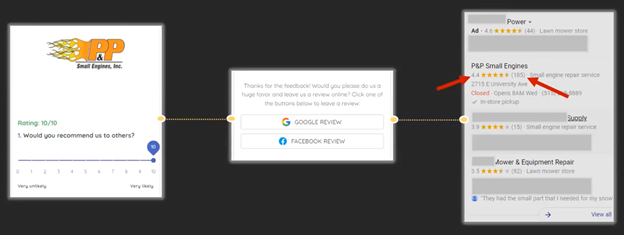How to Gather Feedback from Dealership Customers Year-Round to Drive Repeat Business

It’s never been easier for customers to go online and find a competitive product at a competitive price. How can we make sure that doesn’t happen?
It’s more important than ever to master customer relationships and part of that means understanding feedback.
We may not equate customer feedback to loyalty. We may think feedback equals, let’s say, an upset customer. Sure, that’s part of it—but feedback is primarily not about the negative experiences.
In this guide, I’ll share time-tested strategies for pinpointing where to improve your service experience, how to use feedback to drive more business to your service and parts departments, and how to get more positive feedback from customers in the form of 5-star reviews.
How much do new customers cost your business?
You’ve probably heard metrics floated by marketers and consultants over the years like “new customers cost you eight to ten times more than repeat customers.” But is that really true?
I mean, it makes sense that it costs money to get customers. I’ve spent 10,000 bucks in Google ads in a month. I might get 500 leads and only 100 of those leads actually turn into deals, right?
Let’s break it down:
Let’s say of your 500 leads, 20% of those actually buy from you. $10,000 divided by 500 customers means those hundred customers cost me $100 apiece. That’s my customer acquisition cost (CAC).
So, there there’s the direct cost, but then there’s also the time spent emailing, texting, calling all 100 people, or at least as many of those as our team could get to if they came into the store. Then there’s product demos, writing up quotes, maybe running them for financing. We can’t really track all that labor cost.
Why repeat customers matter
Now, consider this: customers that have bought from you already know what it’s like to do business with you. They don’t have to wonder, “are these folks trustworthy?” Repeat customers are the holy grail. So, how can you keep a customer coming back for life?
We can always throw more money at Google. This might get you more customers, but you have to spend a hundred dollars in marketing spend, plus X amount of dollars in labor.
After all, dealerships aren’t like Chick-fil-A where they’re in and out in 50 seconds. People come out looking to spend anywhere from $20-$40,000 on a tractor or a piece of construction equipment. They’re not going to make that decision on a dime. They want to take their time.
A lot of the labor costs are associated with establishing an initial rapport with your customers. It may even take place over multiple onsite visits.
The key is to capitalize on the customers that already like you.
Track customer experience at your dealership
Customer experience is what drives repeat business.
Knowing that, how can you track your customers’ experience at your dealership?
Peter Drucker has a saying, “If you measure it, you can manage it.”
You can measure the customer experience and thus you can manage it. But to do that, you need to either be there where all the transactions are happening, which for an owner or GM of any sizeable store is pretty much impossible. Or you need to measure it in some way using a tool.
To track customer experience, you need to get customer feedback.
Hear the voice of your customer
Some dealers look at reviews to get an idea of what customers think about them. I would say that for the most part, most dealers have got a decent rating—meaning more customers seem to like them than dislike them.

Reviews are a piece of it, but it’s way downstream from where you really should be measuring the customer experience. I would say that for most dealers, 99% of their customers are not going to Google to voice their feedback, good or bad. In our industry, you have to make it so convenient for the customer.
There are ways to do that. If you want to listen to the voice of your customer start upstream.
To be clear, I’m not talking about your typical survey. Everybody’s gotten those surveys before where you click into them and it’s clear that this thing is going to take at least 20 minutes of your time. Nobody likes those.
I’m talking about something that takes less than one minute to complete.
The voice of the customer is more than just a rating. Ideally, you want to give your customers a place to give you a glimpse into their experience. They can comment and say what went good or bad, “so-and-so went way out of their way to help me, or so-and-so was kind of curt with me.”
I read a lot of surveys in my job. Some people will complain about the labor rate or the time it took to fix something. But more often, when I see complaints, it’s typically because somebody didn’t communicate well, or they didn’t meet expectations. They didn’t return phone calls. They didn’t get authorization to fix something that was fixed. These things have a big impact on the customer experience at your dealership.
Use the net promoter system to gather customer feedback
So how do we get customer feedback? If we want to get a rating and a comment from the customer, I’m a huge fan of the net promoter methodology. A lot of our OEMs are starting to use this too.
I think the net promoter system can be really, really helpful in your business.

Here’s how the net promoter system works:
You ask the customer, “would you recommend us to others?” Then you ask the likelihood of recommending you on a scale of 1-10.
0-6 = detractor (not happy with their experience)
7-8 = passive (neutral about their experience)
9-10 = promoter (very happy with their experience)
There’s a big psychological difference between one and six and seven. Someone who rates your dealership with a one or two is way less likely to recommend you than someone who picks an eight or nine.
From my experience, for most dealers, most customers will give you a nine or 10. Yes. Even during a pandemic, when there are crazy supply chain disruptions. So, there are always attractors. Then, there are typically 5% or fewer passives.
Listen to what passive customers have to say
There’s a lot of value to be found in listening to what the passives and detractors have to say.
Their dissatisfaction could stem from something simple, like if you stopped giving out spare keys by accident, or not giving people their manuals. Oftentimes, if a customer gives you a low rating, it’s not that they are really trying to discourage more people from going to your business. They just had a bad experience.
That’s why it’s worth reaching out to these customers to see if the situation can be salvaged. They’re not all worth salvaging, but many of them are.
Automate getting feedback by using text message
There are old fashioned ways to gather feedback:
- ask customers
- fill out a comment card at the dealership
- call them after they’ve gotten service or bought parts or wholegoods
I’m a huge fan of these, and if you’re doing these right now, don’t stop! But it is hard to do this consistently and at scale.
Typically, if you’re calling them, you’re not going to call somebody who spent five bucks. Because there are only so many hours in the day, you’re going to call somebody who spent 5,000 bucks. Calling is a great way to get feedback but it’s hard to scale.
Personally, I’m a huge fan of post-sale and service text surveys. Now, I’m a little biased – I helped develop a program called TargetCRM that lets dealers automate text surveys. Because we do thousands of transactions at small dealerships, big dealerships, and multiple locations alike, getting feedback at scale is very difficult to do if it’s not automated. That’s where sending post-sale post-service surveys by text message is key.
Because if we have to remember to ask for feedback manually, and we’re adding work to people’s day. That makes it difficult to be done consistently.

What TargetCRM does is automatically send a text message after the customer makes a purchase. Whether it’s a tractor mower, parts, service, TargetCRM differentiates between them. That rating is sent to its respective department automatically. Only happy customers are referred to Google to leave a review.
The reason why I recommend sending surveys by text message, rather than email, is that over 95% of the time, our counter staff is not capturing an email address on the customer record. And what we found is that the average email is not open for at least an hour and a half. Sometimes, emails just go directly into the spam folder.
On the other hand, we have phone numbers nearly all of the time, because many dealers are a phone-based kind of business. On average, customers will see that text message in 90 seconds. Now, that doesn’t guarantee you they’re going to click on your survey and engage with it. But many of them will, enough that you can get enough feedback to learn from them.
The bottom line: listen to your customers
Your customers are already talking to each other. By leveraging tools to help you divert some of that conversation directly to your team, you can keep a finger on the pulse of your customer experience. By regularly receiving feedback from customers, you can course-correct and do what you need to do to keep customers coming back.
Want to learn more about how TargetCRM can help you automatically receive customer feedback?


